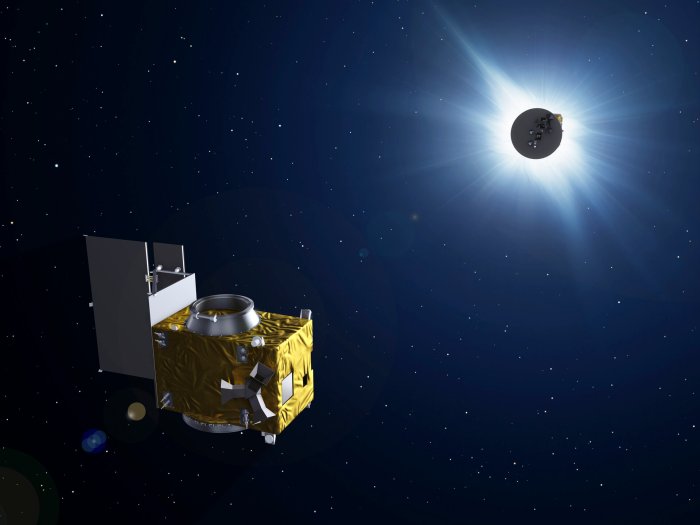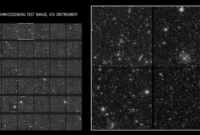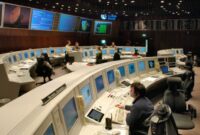Esa plans artifical solar eclipse proba 3 – ESA Plans Artificial Solar Eclipse with PROBA-3, a mission that promises to revolutionize our understanding of the Sun. This ambitious project involves creating an artificial solar eclipse, a feat that has never been achieved before. By precisely aligning two spacecraft, one blocking the Sun and the other observing the corona, scientists aim to unlock secrets of the Sun’s outermost layer, a region that remains shrouded in mystery.
The concept behind this artificial eclipse is surprisingly straightforward. One spacecraft, the occulter, will position itself between the Sun and Earth, effectively creating an artificial shadow. The second spacecraft, the coronagraph, will then observe the corona, the Sun’s outer atmosphere, from a vantage point within this shadow.
This allows for unprecedented views of the corona, free from the glare of the Sun’s disk.
ESA’s PROBA-3 Mission
The PROBA-3 mission, led by the European Space Agency (ESA), is an ambitious endeavor to create an artificial solar eclipse. This unique experiment aims to observe the Sun’s corona, the outermost layer of its atmosphere, with unprecedented detail and accuracy.
The Objectives of the PROBA-3 Mission
The primary objective of PROBA-3 is to study the Sun’s corona, a region of extreme heat and low density that is difficult to observe from Earth. By creating an artificial solar eclipse, PROBA-3 will allow scientists to study the corona in detail, without the interference of the Sun’s bright disk.
The specific scientific objectives of the mission include:
- Studying the dynamics and evolution of the corona, including coronal mass ejections (CMEs) which can disrupt Earth’s magnetic field and cause geomagnetic storms.
- Investigating the mechanisms that heat the corona to millions of degrees, despite being much further away from the Sun’s surface than the photosphere.
- Examining the role of magnetic fields in the corona and their influence on solar activity.
The Significance of Creating an Artificial Solar Eclipse
Creating an artificial solar eclipse is a crucial aspect of the PROBA-3 mission, as it allows scientists to study the corona in detail without the limitations of observing from Earth. Traditional solar eclipses, which occur when the Moon passes between the Sun and Earth, are relatively rare and often occur in remote locations.
Additionally, the duration of a total solar eclipse is limited to a few minutes, making it challenging to conduct detailed scientific observations.By using two spacecraft, PROBA-3 can create an artificial eclipse that is much more controlled and allows for longer observation periods.
The spacecraft are designed to precisely align themselves in a way that blocks out the Sun’s bright disk, enabling the coronagraph instruments on board to study the corona with unprecedented detail.
Technical Challenges of Deploying and Controlling the Two Spacecraft
The successful implementation of the PROBA-3 mission relies heavily on the precision and control of the two spacecraft. The spacecraft, known as “Occulter” and “Coronagraph,” must maintain a precise formation in orbit to create the artificial eclipse. The main technical challenges include:
- Maintaining precise formation flying:The two spacecraft must maintain a specific distance and alignment to create the artificial eclipse. This requires highly accurate navigation and control systems.
- Precise pointing and stabilization:The Coronagraph spacecraft must be precisely pointed towards the Sun, while the Occulter spacecraft must block out the Sun’s disk with high accuracy.
- Communication and data transfer:The two spacecraft must communicate with each other and with ground stations to ensure proper operation and data transmission.
- Autonomous operation:The spacecraft must be able to operate autonomously for extended periods, as communication with Earth can be limited due to orbital constraints.
The PROBA-3 mission represents a significant technological leap forward in space exploration. By creating an artificial solar eclipse, scientists will gain unprecedented insights into the Sun’s corona and its impact on Earth.
Artificial Solar Eclipse Technology

PROBA-3’s primary objective is to create an artificial solar eclipse, enabling scientists to study the Sun’s corona, the outermost layer of its atmosphere, in unprecedented detail. This innovative approach offers a unique opportunity to delve deeper into the Sun’s activity and its impact on Earth.
The Concept of an Artificial Solar Eclipse
An artificial solar eclipse mimics the natural phenomenon by blocking the Sun’s bright disk using a precisely positioned spacecraft, allowing for the observation of the faint corona. This technique allows scientists to study the corona without the need for specialized instruments or the limitations of observing during a natural eclipse.
Key Components and Their Functions
The artificial solar eclipse is achieved through the coordinated operation of two spacecraft:
The Occulter Spacecraft
- This spacecraft acts as the “artificial Moon,” blocking the Sun’s light.
- It is equipped with a large, precisely shaped occulter, designed to block the Sun’s disk effectively.
- The occulter is a thin, lightweight structure that acts as a shadow caster, creating a region of darkness behind it.
- The occulter’s shape and position are carefully calculated to ensure the Sun is completely blocked from view.
The Coronagraph Spacecraft
- This spacecraft houses the instruments that observe the Sun’s corona.
- It is positioned behind the occulter, within the shadow created by the occulter.
- The coronagraph spacecraft’s instruments are specifically designed to detect and analyze the faint light emitted by the corona.
Alignment and Maneuvers
To achieve an artificial solar eclipse, the two spacecraft must be precisely aligned and maneuvered to ensure the occulter blocks the Sun’s light perfectly. This requires a high level of accuracy and sophisticated control systems:
- The occulter spacecraft must be positioned at a specific distance and angle relative to the Sun and the coronagraph spacecraft.
- This precise positioning is achieved through a combination of thrusters and sophisticated navigation systems.
- The two spacecraft must maintain their alignment during the observation period, requiring constant monitoring and adjustments.
- The alignment and maneuvers are carefully planned and executed to ensure the success of the artificial eclipse.
Scientific Applications of the PROBA-3 Mission
PROBA-3, a joint venture between ESA and Belgium, is not just a technological marvel; it’s a powerful tool for advancing our understanding of the Sun. By creating an artificial solar eclipse, the mission aims to shed light on the enigmatic solar corona, the Sun’s outermost atmosphere.
Studying the Solar Corona
The solar corona is a fascinating and complex region, characterized by extremely high temperatures and dynamic activity. Understanding the corona is crucial for several reasons. Firstly, it’s the source of the solar wind, a constant stream of charged particles that can impact Earth’s atmosphere and technologies.
Secondly, the corona is the site of powerful solar flares and coronal mass ejections, which can disrupt communication systems and power grids on Earth. PROBA-3’s artificial solar eclipse provides a unique opportunity to study the corona in unprecedented detail. By blocking out the overwhelming light from the Sun’s photosphere, the mission allows scientists to focus on the faint corona, revealing its intricate structures and dynamics.
The artificial eclipse allows us to study the corona in unprecedented detail, revealing its intricate structures and dynamics.
The mission will use a combination of instruments to study the corona. These instruments include:
- Coronagraphs:These instruments block out the Sun’s light to reveal the corona. PROBA-3 will use two coronagraphs, one to observe the inner corona and the other to observe the outer corona.
- Spectrometers:These instruments analyze the light from the corona to determine its composition and temperature.
- Polarimeters:These instruments measure the polarization of light from the corona, providing information about the magnetic fields in this region.
Potential for New Discoveries
PROBA-3’s unique capabilities offer the potential for groundbreaking discoveries in solar physics. Some of the key scientific questions that the mission aims to address include:
- The heating of the corona:The corona is significantly hotter than the Sun’s surface, a phenomenon that is not fully understood. PROBA-3 will help scientists investigate the mechanisms responsible for this heating.
- The origin of the solar wind:The solar wind originates from the corona, but the exact processes involved are still debated. PROBA-3 will provide valuable insights into the origin and acceleration of the solar wind.
- The dynamics of coronal mass ejections:Coronal mass ejections are powerful eruptions of plasma from the Sun that can have significant impacts on Earth. PROBA-3 will help scientists understand the triggers and dynamics of these events.
- The role of magnetic fields in the corona:Magnetic fields play a crucial role in the corona, driving its activity and shaping its structures. PROBA-3 will provide detailed measurements of the coronal magnetic field.
By addressing these fundamental questions, PROBA-3 will contribute significantly to our understanding of the Sun and its impact on Earth. The mission’s innovative approach and advanced instrumentation will pave the way for new discoveries and advancements in solar physics.
Obtain access to buddywise ai startup spots workplace accidents to private resources that are additional.
Comparison with Natural Solar Eclipses
PROBA-3’s artificial solar eclipse, while a fascinating technological achievement, is fundamentally different from natural solar eclipses. Understanding these differences is crucial to appreciating the unique capabilities and limitations of each method.
Advantages and Disadvantages of Artificial vs. Natural Eclipses
The comparison between artificial and natural eclipses highlights their distinct advantages and disadvantages:
- Artificial Eclipse Advantages:
- Control and Predictability:Artificial eclipses offer precise control over the duration, location, and size of the eclipse. This allows for more targeted scientific observations and eliminates the uncertainties associated with natural eclipses.
- Frequency and Accessibility:Unlike natural eclipses, which are infrequent and geographically limited, artificial eclipses can be generated on demand, enabling more frequent and accessible observations.
- Cost-Effectiveness:While the initial development costs for PROBA-3 are significant, the ability to generate eclipses on demand eliminates the need for costly travel and logistics associated with observing natural eclipses.
- Artificial Eclipse Disadvantages:
- Limited Duration:The current PROBA-3 design allows for a maximum eclipse duration of 30 minutes, significantly shorter than the several minutes of totality experienced during natural eclipses.
- Limited Size:The artificial eclipse created by PROBA-3 is smaller than the shadow cast by the Moon during a natural eclipse, limiting the area of observation.
- Natural Eclipse Advantages:
- Larger Eclipse Area:Natural eclipses cast a much larger shadow, enabling observations over a wider geographical area.
- Longer Duration:Total solar eclipses can last for several minutes, providing a longer window for scientific observations.
- Natural Eclipse Disadvantages:
- Infrequent Occurrence:Natural solar eclipses are relatively infrequent events, with total solar eclipses occurring at a specific location only once every few hundred years.
- Geographic Limitation:The path of totality for a natural eclipse is narrow and traverses a specific region, limiting accessibility for researchers and observers.
- Unpredictable Weather:Natural eclipses are susceptible to weather conditions, which can obscure the eclipse and disrupt observations.
Unique Capabilities of Artificial and Natural Eclipses
Both artificial and natural eclipses offer unique capabilities for scientific exploration:
- Artificial Eclipse Capabilities:
- Precision and Control:Artificial eclipses provide precise control over the duration, location, and size of the eclipse, enabling researchers to conduct controlled experiments and focus on specific aspects of the Sun’s corona.
- Repeatability:The ability to generate eclipses on demand allows for repeated observations, facilitating long-term studies of solar phenomena and their evolution.
- Natural Eclipse Capabilities:
- Large-Scale Observations:The larger shadow cast by the Moon during a natural eclipse enables observations across a wider geographical area, providing a broader perspective on solar activity.
- Extended Observation Time:The longer duration of totality during natural eclipses allows for more in-depth studies of the Sun’s corona and other solar phenomena.
Potential for Synergy between Artificial and Natural Eclipses
While artificial and natural eclipses have distinct advantages and disadvantages, there is potential for synergy between the two:
- Complementary Observations:Artificial eclipses can be used to complement observations made during natural eclipses, providing a more comprehensive understanding of solar phenomena.
- Cross-Validation:Comparing data from artificial and natural eclipses can help validate and refine our understanding of solar activity and the Sun’s corona.
- Enhanced Research Capabilities:Combining the controlled nature of artificial eclipses with the large-scale and extended observation time of natural eclipses can significantly enhance our research capabilities.
Future Applications and Potential Impact: Esa Plans Artifical Solar Eclipse Proba 3
PROBA-3’s artificial solar eclipse technology holds immense potential beyond scientific research, paving the way for innovative applications across various fields. This technology could revolutionize our understanding of the Sun and its influence on Earth, opening new avenues for space-based solar observation and forecasting.
Applications Beyond Scientific Research
The ability to create an artificial solar eclipse offers numerous possibilities for practical applications:
- Spacecraft Thermal Management:By precisely controlling the amount of sunlight reaching a spacecraft, PROBA-3’s technology can be used to regulate its temperature, reducing the need for bulky and energy-intensive cooling systems. This could be particularly valuable for long-duration missions in harsh environments.
- Solar Power Optimization:Artificial eclipses can be used to fine-tune the output of solar panels in space, maximizing energy generation and efficiency. This could be vital for future space-based solar power stations, allowing them to operate with greater precision and reliability.
- Satellite Communication:By blocking solar radiation, PROBA-3’s technology could be used to reduce interference in satellite communication systems, ensuring clearer signals and improved data transmission. This is crucial for applications like GPS, telecommunications, and Earth observation.
- Space-Based Telescopes:Artificial eclipses could be employed to create a controlled environment for space-based telescopes, enabling them to observe faint objects and celestial phenomena without the glare of the Sun. This would be instrumental in advancing our understanding of the universe.
Impact on Solar Science and Earth, Esa plans artifical solar eclipse proba 3
PROBA-3’s mission will significantly contribute to our understanding of the Sun and its impact on Earth:
- Solar Activity Monitoring:The artificial eclipse allows for precise measurements of the Sun’s corona, the outermost layer of its atmosphere, providing crucial data for understanding solar flares and coronal mass ejections (CMEs). These events can disrupt Earth’s magnetic field and have a significant impact on communication systems, power grids, and satellites.
- Space Weather Forecasting:By studying the Sun’s activity with greater precision, PROBA-3 can contribute to improved space weather forecasting, enabling us to better predict and mitigate the potential risks of solar storms. This is essential for protecting critical infrastructure and ensuring the safety of astronauts in space.
- Climate Change Research:The Sun’s influence on Earth’s climate is a complex and crucial aspect of climate change research. PROBA-3’s data can help us better understand the Sun’s role in climate variability, providing valuable insights for climate models and predictions.
Future Missions and Advancements
PROBA-3 is a pioneering mission that lays the groundwork for future advancements in space-based solar observation:
- Next-Generation Solar Telescopes:The success of PROBA-3 will inspire the development of more sophisticated space-based solar telescopes, capable of capturing even finer details of the Sun’s activity and providing unprecedented insights into its behavior.
- Artificial Eclipse Networks:Future missions could deploy a network of spacecraft capable of creating artificial eclipses at different points in space, allowing for continuous monitoring of the Sun and its influence on Earth.
- Advanced Solar Modeling:Data from PROBA-3 and future missions will feed into advanced solar models, leading to a more comprehensive understanding of the Sun’s internal structure, magnetic field, and activity cycles.





